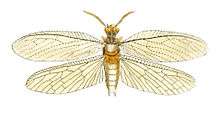Chauliodes pectinicornis
Chauliodes pectinicornis is a species of fishfly from North America.
| Chauliodes pectinicornis | |
|---|---|
 | |
| Scientific classification | |
| Kingdom: | Animalia |
| Phylum: | Arthropoda |
| Class: | Insecta |
| Order: | Megaloptera |
| Family: | Corydalidae |
| Genus: | Chauliodes |
| Species: | C. pectinicornis |
| Binomial name | |
| Chauliodes pectinicornis | |
| Synonyms | |
| |
Summer Fishfly
Identification:
Head: Dark brown with yellow to cream-colored marks; two side by side on top of head, and one mark behind each eye.
Antenna: Dark brown to black, comb-like or feathered on both male and female.
Thorax: Neck (prothorax) squarish, almost as wide as head. Thorax dark brown with yellow to cream-colored streak down center and at each side.
Wings: Tan to light brown, veins mixed dark brown and cream-colored. 27 to 42 crossveins on costal edge.
Legs: Legs yellowish, feet dark brown.
Similar Species: The Spring Fishfly C. rastricornis flies earlier and has a lighter brown head and marks are dark, almost black. Female has serrated antennae, male antenna feathered (comb-like or pectinate).
Size: Very large 25 to 45 mm long body. Male is smaller.
Flight Time: Mid-July to mid-August.
Habitat: Ponds, bogs, swamps, springs, forest vernal pools and even treeholes.
Food: Larvae feed on small aquatic insects. Adults have taken sugar water in the lab, so possibly feed on nectar.
Life Cycle: Females lay large masses of 1,000 to 2,000 eggs in rows on leaves or rocks over-hanging the water. Eggs are reddish-brown with no protective coating like Corydalus. Five to six day later, eggs hatch and drop into the water at night. Carnivorous, feeding on Alderflies Sialis, Caddisflies Trichoptera, flies Diptera and even their own species.
The abdomen of the larvae has a yellowish line down the middle. Similar C. rastricornis has a black mid-line. Dobsonflies Corydalus and Alderflies Sialis have a feathery tail, absent on Chauliodes.
The pupa is curved, without a cocoon and is capable of moving. They pupate in partially submerged in water, preferring decayed logs in the water or along pond edges. Emerge in about 10 to 15 days at night. One generation per year, overwintering as larvae.
References:
Catalogue of the Specimens of Neuropterous Insects in the Collection of the British Museum of Natural History, 1853, Part 2, pp. 198 to 200.
Smithsonian Miscellaneous Collections, 1861: Synopsis Neuroptera of North America by Hagen, pp. 189 to 190.
Guide to the Study of Insects by Packard, 1869, pp. 600 to 607.
The Standard Natural History, 1886, Vol. 2, by Kingsley, pg. 156.
Ohio Agricultural Experiment Station Technical Series, 1889, Bulletin Vol. 1, #1: Studies in Pond Life by Weed, pp. 9 to 10.
New York State Museum, 1903, Bulletin 68: Aquatic Insects in New York State by Davis, pp. 446, 453 to 462.
Annals of the American Entomological Society, 1922, Vol. 15, pp. 169 to 171 by Smith.
Ohio State University, 1960: Revision Chauliodes and Nigronia; Thesis Hazard.
Entomological News, 1976, Vol. 87 #7-8: New State Records of Fishflies by Tarter et al, pg. 223.
Banisteria, 1994, #3: A Novel Habitat for Larvae of the Fishfly Chauliodes pectinicornis by Fashing pp. 25 to 26.
Canadian Journal of Zoology, 1988, Vol. 66: Cave Fauna of Canada and Ontario, pg. 1204 by Peck.
Proceedings of the California Academy of Sciences, 1997-98, Vol. 50, #3, pg. 53 by Penny et al.
Entomological News, 1997, Vol. 108: A South Dakota Record for Chauliodes rastricornis by Johnson, et al.
Types:
Holotype unknown. United States specimens from the Entomological Club (Philadelphia); Delaware by Doubleday; Massachusetts from Sheppard’s collection are in the British National Museum of Natural History, London, England.
Distribution
C. pectinicornis has a wide distribution in the eastern Canada and United States, from Maine in the north-east to Alachua, Liberty and Santa Rosa counties in Florida to the south-east, and as far west as Kansas.[1]
Taxonomic history
C. pectinicornis was first described by Carl Linnaeus in his 1763 work Centuria Insectorum.[2]
Synonyms: Linnaeus 1763
Hemerobius pectinicornis, Hemerobius virginiensis, Semblis pectinicornis, Chauliodes virginiensis.
References
- Lionel Stange (November 20, 2000). "A Checklist and Bibliography of the Megaloptera and Neuroptera of Florida". Florida State Collection of Arthropods. Retrieved June 24, 2010.
- "Detailed record for Chauliodes pectinicornis (Linnaeus, 1763)". Essig Museum of Entomology Species Lists. University of California, Berkeley. Retrieved June 16, 2010.